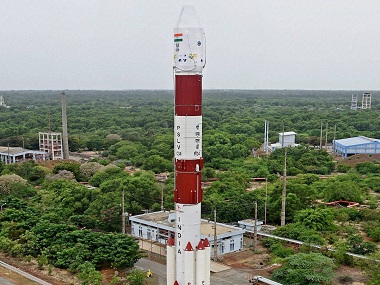“Success has become a way of life for Isro. But we never get carried away by success.”
This remark by a senior scientist of the Indian Space Research Organisation (Isro) summed up the mood in the control room at India’s spaceport in Sriharikota after the hugely successful PSLV- C34 mission on Wednesday morning.
This was the 36th flight of the Polar Satellite Launch Vehicle (PSLV) and the 34th successful launch in a row. The rocket has launched over 110 satellites, including 57 from international customers and space agencies. Wednesday’s was the fourth flight of PSLV in 2016. All these statistics reiterate the fact that PSLV has indeed become the workhorse of the Indian space agency and its mascot of success.
Just because the PSLV is being launched again and again, and with success, does not mean that the Isro is doing it mechanically. Yes, systems have been developed for everything that is required for repetitive launches — preparing multiple stages of the rocket, fuel supplies, satellite fabrication, integration, launch, as well as command and control.
Yet every launch of PSLV comes with specific challenges that require innovative technical and technological solutions. In this sense, no two launches of PSLV are carbon copies. Every time the requirements of mission are different and system has to be tailor made for the passengers — satellites — the PSLV carries.
PSLV-C34 posed two major challenges: It had to launch a record number of satellites — 20 in all. Second, the primary satellite — 727.5 kg Cartosat-2 series satellite — had to be launched in a polar sun synchronous orbit (SSO), while 19 other co-passengers together weighing 560 kg had to be launched in a slightly different orbit, that too separated by a safe distance. This was the technological challenge that scientists successfully met in this mission.
 To begin with, the most powerful version of PSLV — the XL version that has six strap-on motors to give it extra boost — was used for the launch of 20 satellites. In the past, Isro has executed 17 missions in which multiple satellites were launched. In 2008, PSLV was used to launch a set of 10 satellites in low Earth orbit. This time around 20 satellites were on board and they had to be injected precisely in SSO.
To begin with, the most powerful version of PSLV — the XL version that has six strap-on motors to give it extra boost — was used for the launch of 20 satellites. In the past, Isro has executed 17 missions in which multiple satellites were launched. In 2008, PSLV was used to launch a set of 10 satellites in low Earth orbit. This time around 20 satellites were on board and they had to be injected precisely in SSO.
Two sets of new technologies were deployed in the PSLV–C 34 mission. A set of separation technologies was used to achieve precise and safe separation of four stages of the rocket and injection of satellites into their respective orbits. The type of separation or jettisoning system employed in a mission depends on several factors such as the jettisoning speed required and the shock load. For instance, the Flexible Linear-Shaped Charge (FLSC) was used for separation of the first stage. Separation of different stages is the most critical and challenging part of a space flight. This was successfully achieved in Wednesday’s flight.
Source From : firstpost.com



